Of particular importance during our visit to Beijing was the opportunity to try Beijing duck. Being the milquetoasts that we are, this turned out to be more of an adventure than we anticipated.
First, there was the question of how we were going to make a reservation. Our guide book (without which we would have been hard pressed to function well) suggested a restaurant but made it clear that the staff insisted upon a reservation. Had they not used the word ‘insisted’, we might not have bothered but, in the end, we decided to just call and see if we could bludgeon our way through the language in order to book a spot. Marc lost the rock-paper-scissors and so he made the call. “We may or may not have a table for two at seven.”
Now the second challenge: find the restaurant. Our obstacles were the following: different spellings of the name of the restaurant depending on which map we consulted, an inability to pronounce the name of the restaurant properly, an address within a maze of hutong (small alleyways) which didn’t appear on any map we had, and a city in a frenzy of destruction and reconstruction of great areas of itself in anticipation of the 2008 Olympics. We had tried to find a bar the day before and were completely unsuccessful owing to the fact that not only had the bar changed its name and moved, the building it was in, and almost the whole street it was on, was in the process of being torn down. We gave ourselves a 30-minute window to this restaurant that looked to be approximately 5 blocks away. 28 minutes after setting out, Marc returned breathless to the spot I had been waiting while he scouted out the area for the restaurant. It had been an unsuccessful mission. Also, after 20 minutes of waiting , I started worrying that he had fallen into an open excavation and that, while standing there alone on the street corner in my only nice outfit, people were probably beginning to think I was a lady of the night.
As a last ditch effort, we approached a rickshaw driver and pointed to the name of the restaurant written in Chinese characters. He was happy to offer to take us there for what amounted to quite an inflated price. We in no position to bargain very much and so settled on a price quickly and jumped into the back of his converted motorcycle-rickshaw. A few weaving alleyways later, he stopped to ask for directions and we exchanged a glance that asked “should we turn back now or let ourselves become even more lost than we ever have before?” Just then, Marc spotted a sign for the place “Liqun Roast Duck Restaurant” and we hopped out in front of a place that truly lives up to the description of being a hole in the wall. Though these often prove to be where the best food is, so I was actually a little encouraged, if extremely over-dressed.
We walked inside, past the open, wood-burning stove, into a very crowded restaurant. We managed to charade that we had called for a reservation. A woman nodded and led us past a couple of other waiting fellows to our table in the back. Seconds later, the two fellows that were waiting at the front joined us at our table for four which, we guessed, meant that we were sharing. Not to worry, we ordered two of the ‘house specialty’ which looked to be roast duck with an assortment of appetizers (?) and beer. As the plated began to arrive, we learned that our neighbours had ordered the same thing and we found out that they were Japanese. A table of tourists!
And now the next challenge: figure out what we’re about to eat and how to eat it. We got six plates immediately: a plate of small, thin crepes, some broccoli, spears of cucumber, a dish with brown sauce and slivered scallions, a plate of ??, and something that looked like duck foie gras. We tasted each and, indeed, all were as we thought, including dish xyz, which was made up of a vegetable – more scallion? – and a meat – unidentifiable, slightly chewy, but not unpleasant. Normally, an unidentifiable meat would seem a bit disconcerting but I’ve lost track of the number of times we’ve been served something which we are completely unable to identify beyond being a part of either the plant or animal kingdom and we just have to dive right in. Most often, we eat the whole plate of miscellany without ever having been able to identify what it was, so we didn’t have much concern about tucking into this meal. However, at this point, I broke the number one rule of eating miscellany in China: don’t examine it. After a few bites, I had a closer look and it came to me that this was probably a plate of duck tongues. And then I was only able to to manage a few more bites before imaging the quacks that these tongues had once made and I pushed the dish aside. I didn’t feel too badly about it as our Japanese table mates hadn’t even touched their foie gras.
After some time, our neighbours’ roast duck arrived. It came whole, with the head attached, and we all took pictures before it was carved (which came as a relief as I was a little worried that we’d be presented with the whole thing and left to fend for ourselves armed only with wooden chopsticks and a sharpened bottle cap).
It was served on an enormous plate and there was enough lovely carved meat and crispy, fatty skin to have fed all four of us. They started in while our duck arrived for its photo session. It turns our that we were pretty lucky to have been sitting with these two as one fellow was living in Beijing and showed us the proper way to eat it: fill a thin crepe with duck and a little of each of the plates of what we had thought were appetizers, roll it up and dip into the brown sauce. With encouragement, further instruction and many napkins, we were able to eat our traditional Beijing Roast Duck and it was delicious, further strengthening the theory that some of the best food is served in the seediest joints.
Now that we had become friends, our table mates asked for a couple of extra glasses and offered us a shot of the beiju they were drinking. I had read about this drink, a traditional rice wine with over 50% alcohol content. Of course, we accepted. And again, and again- pause to order a second bottle – and again. It made the duck taste even better.
After all that adventure, and all that rice wine and beer, we figured we could find our way back through the maze to the hostel. Fortunately, our dumb luck led us straight there, where we could recommend this wonderful restaurant to other travelers.
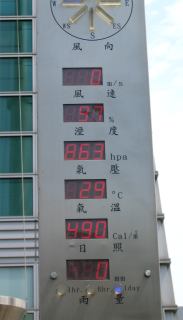
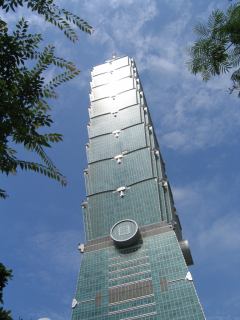 On our first day, it seemed so lovely to be so warm and let our skin absorb the moisture in the air. “Isn’t it so nice,” we said, “that we can walk around in the evening and not wear a jacket!” Then the rain started falling, and we thought “Oh my, a little sprinkle. We had better go back to the hostel.” And then we got trapped by the DOWNPOUR of rain, under an awning fifty feet from our door. (That was Lesson #45 of being in Asia- we continue a burn-rate of 20 Lessons/day.) The next day, we began our touristing with a walk to Taipei 101, currently the tallest building in the world. The building was great, the heat was astonishing.
On our first day, it seemed so lovely to be so warm and let our skin absorb the moisture in the air. “Isn’t it so nice,” we said, “that we can walk around in the evening and not wear a jacket!” Then the rain started falling, and we thought “Oh my, a little sprinkle. We had better go back to the hostel.” And then we got trapped by the DOWNPOUR of rain, under an awning fifty feet from our door. (That was Lesson #45 of being in Asia- we continue a burn-rate of 20 Lessons/day.) The next day, we began our touristing with a walk to Taipei 101, currently the tallest building in the world. The building was great, the heat was astonishing.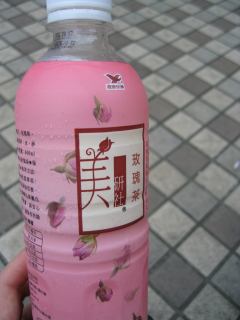 After having bought about 10 bottles of water, I convinced Marc to try something new: sweetened rose water. It tastes great and, when the cold bottle is held to the forehead, it seems to create the illusion of being cool for a couple of seconds.
After having bought about 10 bottles of water, I convinced Marc to try something new: sweetened rose water. It tastes great and, when the cold bottle is held to the forehead, it seems to create the illusion of being cool for a couple of seconds.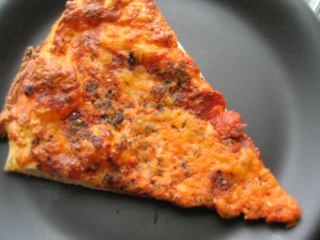 We had to pack a lot of food into one day and two nights. On our first night I insisted we order from Salvatore’s Pizza. They make a plain cheese pizza to die for. We also split a mushroom and garlic pizza, a meatball hero and a salami-pepperoni hero. This was a traditional meal of Danny J and me. I used to favour the salami-pepperoni hero over the meatball, but this time was different. The meatballs are sliced and covered in cheese and sauce. The texture clearly states the sandwich is full of fat. It’s worth it.
We had to pack a lot of food into one day and two nights. On our first night I insisted we order from Salvatore’s Pizza. They make a plain cheese pizza to die for. We also split a mushroom and garlic pizza, a meatball hero and a salami-pepperoni hero. This was a traditional meal of Danny J and me. I used to favour the salami-pepperoni hero over the meatball, but this time was different. The meatballs are sliced and covered in cheese and sauce. The texture clearly states the sandwich is full of fat. It’s worth it. The next day required an extra lunch to fit in all the mandatory stops. Ray’s at Scotia Square has a wide selection of Lebanese food. I hadn’t been there in three years. Nothing is fried. Everything is low fat. I always order the barbeque chicken pita. Rather than lettuce, he adds salad with tomatoes and pita croutons. The croutons add a great crunch. The oddest ingredient is roasted potatoes. He finishes it off with hummous and tahini sauce. I guess I’ve been there a lot. Ray looked and me and says, “it’s been a long time.”
The next day required an extra lunch to fit in all the mandatory stops. Ray’s at Scotia Square has a wide selection of Lebanese food. I hadn’t been there in three years. Nothing is fried. Everything is low fat. I always order the barbeque chicken pita. Rather than lettuce, he adds salad with tomatoes and pita croutons. The croutons add a great crunch. The oddest ingredient is roasted potatoes. He finishes it off with hummous and tahini sauce. I guess I’ve been there a lot. Ray looked and me and says, “it’s been a long time.” Steve-o-reno’s has the best coffee in Halifax. We both ordered the double short latte. It wasn’t as good as the Blue Bottle Company in San Francisco, but still very good.
Steve-o-reno’s has the best coffee in Halifax. We both ordered the double short latte. It wasn’t as good as the Blue Bottle Company in San Francisco, but still very good.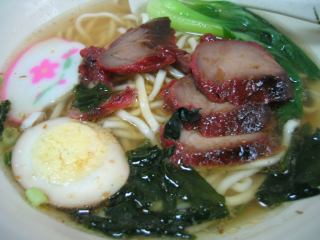 Food can be a little challenging. The key factor is selecting a food stand where we can communicate what we want. Some restaurants and stands have pictures, others have English menus. Some just have food on display at which to point. It’s also possible to point at meals that have been served to other people. Most food vendors seem used to selling food in this fashion.
Food can be a little challenging. The key factor is selecting a food stand where we can communicate what we want. Some restaurants and stands have pictures, others have English menus. Some just have food on display at which to point. It’s also possible to point at meals that have been served to other people. Most food vendors seem used to selling food in this fashion. Dessert was a bit of surprise. I picked out something pink from a display case with the assumption it was soft, fluffy and creamy. I’m glad we didn’t wait until we got back to the hostel to eat it because it turned out to be frozen. The outside was covered in sticky gelatinous rice. The inside was like strawberry ice cream, but with a slightly waxy texture. We’re sure to have more pleasant surprises.
Dessert was a bit of surprise. I picked out something pink from a display case with the assumption it was soft, fluffy and creamy. I’m glad we didn’t wait until we got back to the hostel to eat it because it turned out to be frozen. The outside was covered in sticky gelatinous rice. The inside was like strawberry ice cream, but with a slightly waxy texture. We’re sure to have more pleasant surprises.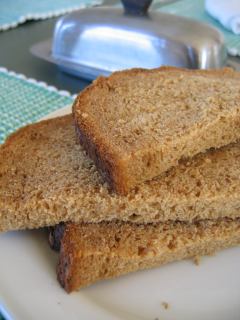 My mother made this wonderful molasses bread for Janet and me. I couldn’t get enough. The molasses adds a lot of flavor, but doesn’t make the bread sweet. My mom said it should have risen more. Personally, I like a dense bread. It has more flavor per bite, and it feels hearty when eating it.
My mother made this wonderful molasses bread for Janet and me. I couldn’t get enough. The molasses adds a lot of flavor, but doesn’t make the bread sweet. My mom said it should have risen more. Personally, I like a dense bread. It has more flavor per bite, and it feels hearty when eating it.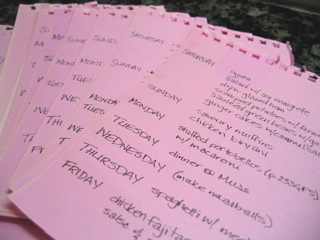 Today we move from documenting our recipes to documenting our travels, from weekly menus to schedules. Our pots and pans are in boxes, our fridge is empty, our bags are packed. We will experience the culinary adventures of road-side stands and back alley restaurants. Our blog won’t be limited to epicurian delights and nerdly musings, but neither will it contain long rants about uncomfortable trains.
Today we move from documenting our recipes to documenting our travels, from weekly menus to schedules. Our pots and pans are in boxes, our fridge is empty, our bags are packed. We will experience the culinary adventures of road-side stands and back alley restaurants. Our blog won’t be limited to epicurian delights and nerdly musings, but neither will it contain long rants about uncomfortable trains. In the midst of packing, we took a little break to drink
In the midst of packing, we took a little break to drink 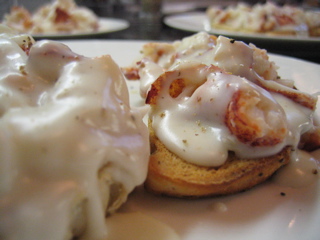
 For breakfast, I filled a herb omlette with lobster and green onions. It was ok. Nothing too exciting compared to the previous two.
For breakfast, I filled a herb omlette with lobster and green onions. It was ok. Nothing too exciting compared to the previous two.